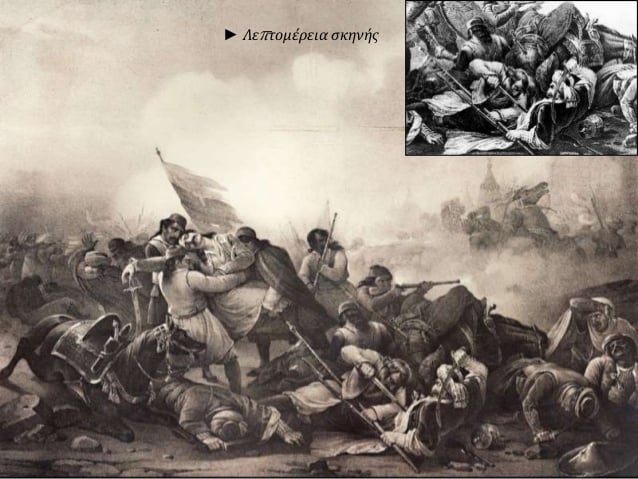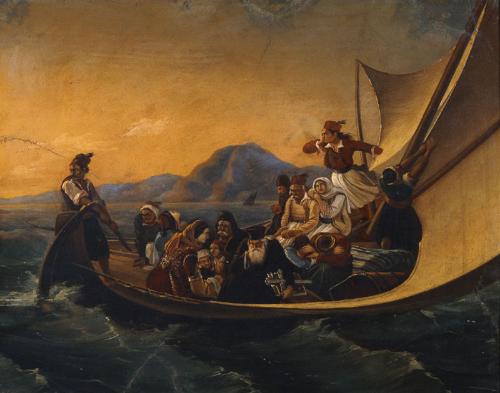On the morning of June 21, 1824, the island of Psara, which had joined The Greek War of Independence on April 10, 1821, was invaded by the Turkish fleet, comprising 176 ships (warships and transports), that had sailed from Mytilene heading for Psara carrying 17,000 Turkish and Albanian troops.

At this stage of the war, losses were great on both sides The initial Greek successes were now beginning to ebb and Sultan Mahmud II decided to take stock of the situation by studying the causes of his defeat and the loss of his armies and fleets. He observed that whilst his own losses were great, his resources were not diminished. Realising that the mainland Greeks would defend their liberty to the end, he, therefore, changed tactics and decided to recover the command of the sea.
The Greeks were not in a position to replace the loss of ships as was the Ottoman Navy which could re-build a fleet each year.
The sultan, therefore, decided to lay waste the islands of Kasos and Psara, not only because they were the most exposed of the Greek naval bases, but because their cruisers inflicted extensive losses on the Turkish population and a resulting victory world be a great boost to Ottoman morale.
Kasos, lying between Karpathos and Crete, was the first to be attacked by the Egyptian fleet of Mohammed Ali under the command of Ismael Gibraltar Pasha.
On board, the three frigates and ten sloops of war were three thousand Albanians who would fight under the leadership of Hussein Bey Djeritlee, an able officer who would later die at Mesolonghi.
Kasos was ill-fortified and when they landed on the night of 19th June 1924, the Albanians, experienced in mountain warfare, quickly made their way over the rocky terrain, taking the Kasiots by surprise. All the men were killed and more than two thousand women and children were enslaved.

Meanwhile, Khosreff Pasha sailed from the Dardenelles in the month of May and after a minor attack on Skopelos, returned to Mytilene where he was soon joined by transports carrying three thousand janissaries.
After being joined by another four thousand “Asiatic” troops, he set sail for the island of Psara. At the time, it was estimated that there were 30,000 people on the island, 7,000 of which were locals and the rest refugees from Asia Minor and nearby Chios, which had been destroyed two years earlier.
The forces defending Psara included 1,300 Psarians, 700 refugee troops, and 1,027 mercenaries from Macedonia and Thessaly. The island’s 100 ships were a sizeable force that posed a thorn in Turkish naval operations.
It must be said that at this point, Psara had the incurred the Sultan’s wrath due to the rising fame of one of its inhabitants –Admiral Constantine Kanaris.
Born and raised on the island, Kanaris supported himself by becoming a seamanlike most members of his family since the beginning of the 18th century. He was hired as a boy on the brig of his uncle Dimitris Bourekas. He soon distinguished himself as a fire-ship captain and it was under his command that the Greek navy destroyed the flagship of the Turkish admiral Kara-Ali Pasha in revenge for the Massacre at Chios.
The Sultan had a long memory and now the Psarians would pay dearly.

The islanders were aware of the impending invasion and had begun reinforcing the island’s defences, especially around the southern and western beaches, as the shores around the north and east were steep and inaccessible. The parliament of Psara undertook its role as coordinator of the defences.
Psara had a very democratically-minded tradition, and the inhabitants staged yearly elections in which all social classes participated and elected 40 representatives, who in turn elected five elders.
The author and historian, George Finley, pointed out in his History of the Greek Revolution: Volume II, that the Psarians were a presumptuous lot, “domineering and possessing the insolence of the ancient Athenians.” They quarrelled with their neighbours, namely the Samians and overestimated their own knowledge of military affairs they made a grave mistake when they laid up their fleet in Antipsara and employed the sailors as gunners on land alongside an army of well-armed but unruly soldiers without a leader. By doing this, they rendered their ships useless.
The attack on Psara was skillfully planned.
The Turkish armada dropped anchor at the shallow Bay of Kanalos on the island’s northwest side on the afternoon of the same day it sailed.
Khosreff, with ten ships, opened fire on the batteries whiles he detached a part of his fleet in a direction of a place visible from the town, thus inducing the Psarians to believe this is where the Turks would land. However, naval scouts found they could disembark at the place called Cavo Markaki.
Concealing themselves from view, the Turks reached the heights of the town, unfurled the Turkish flag and began the systematic roundup and slaughter of the inhabitants.
The scenes that followed were unimaginable.
The streets were strewn with the corpses of old men, women and children. Terrified, many Psarians tried to flee. Those whose retreat was cut-off put up a desperate resistance. Eight thousand people were killed or taken into slavery. The victorious Turks slew every male capable of bearing arms and piled the heads of the vanquished into one pyramidal trophy.
The only resistance remaining by the end of June 21 was the small fort of Palaiokastro on the hill called Mavri Rahi (Black Ridge) that dominates the island’s capital. Around 500 fighters and civilians defended the fort against around 6,000 Turkish troops. When the Turks broke through the defences, Antonios Vratsanos blew up the powder magazine killing the defenders and the assaulting Turks.
The destruction of Psara dealt a serious blow to the revolutionary effort as it destroyed a vital portion of the Greek navy. Like Chios two years earlier, and then Kasos, the destruction of the island was tremendous. Of the 30,000 inhabitants, 18,000 were massacred or sold as slaves.
The picture of the destruction was given in the moving poem by Dionysios Solomos:
On the Black Hill of Psara, Glory walking home
contemplates the brilliant young warriors
and wears a wreath on her head
made of a few weeds that were left on the desolate earth.

Of the 100 or so Psarian ships, only 16 managed to escape along with seven fire-ships under Admiral Kanaris. The survivors sought refuge in Monemvasia, and after the liberation of Greece settled in the area of the ancient city of Eretria on Evia.
As for Sultan Mahmud II, his PR campaign was successful. In Asia Minor, the Turks were overjoyed. Festivities took place and the slave markets of Smyrna and Constantinople overflowed with women and children for sale. Most of those captured on Kasos had already been taken away to the slave market in Alexandria.
After 1862, the old inhabitants gradually began to return to the island where they lived, isolated, under Turkish domination until the island became a part of Greece on 21 October during The First Balkan War. After the destruction of his home island, Admiral Kanaris continued to lead his men in attacks against the Turks, until the Battle of Navarino on October 20, 1827. Then the Turkish-Egyptian fleet was destroyed by the combined naval forces of Britain, France and Russia.
Following the end of the war and the independence of Greece, Constantine became an Admiral of the new Greek Navy, He later became a prominent politician.

